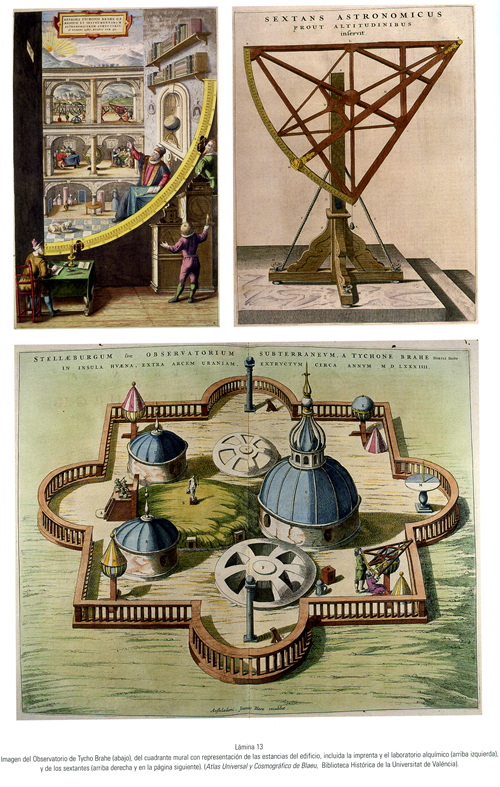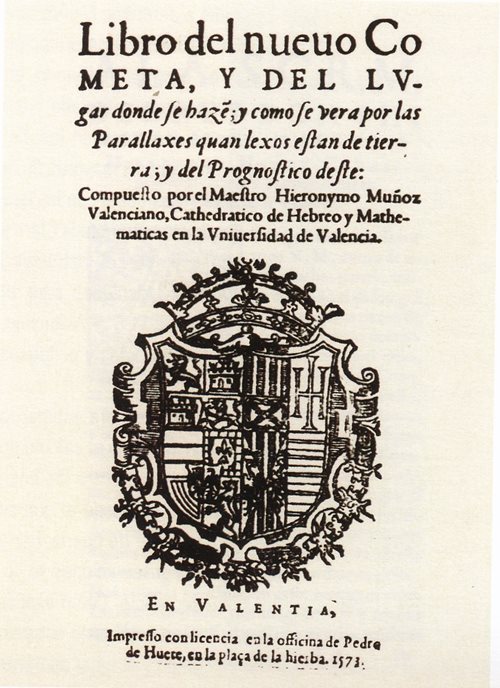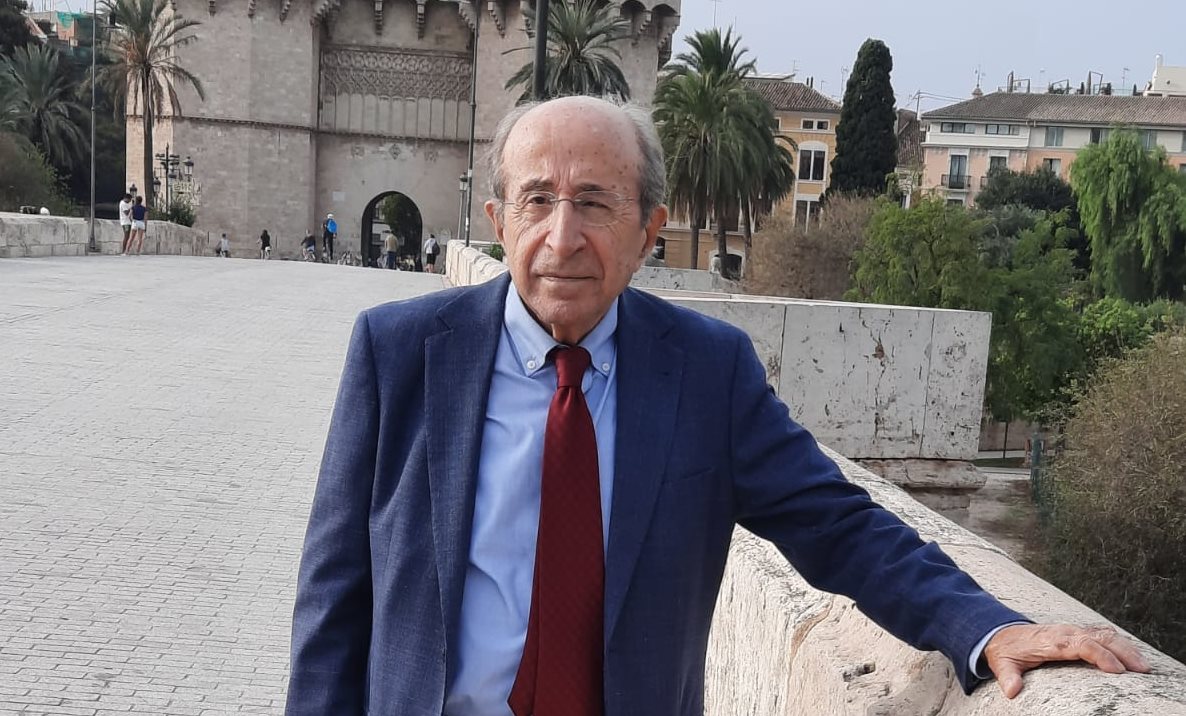On the fifth centenary of Jerónimo Muñoz: mathematics, cosmology and humanism in the Renaissance era
Jerónimo Muñoz (Valencia, c. 1520-Valladolid?, 1591) is undoubtedly one of the most outstanding scientists in Valencian and Spanish history. He was a full professor of Hebrew at the University of Ancona (Italy) and of mathematics and astronomy at the universities of Valencia and Salamanca. During his time, he enjoyed enormous prestige in Spain and in Europe, especially thanks to his work on the supernova of 1572, widely cited and commented on by the best European astronomers, works that are still used to study the remnant of this phenomenon. Muñoz is among the authors who determined the position of the star with greater precision and who better understood the cosmological implications of the phenomenon. Although he published few works, he left an important volume of manuscripts on the various branches of mathematics and astronomy of the time and his applications, testimony to his activities and teachings in universities. The first map of the Kingdom of Valencia published in Antwerp (1584/84) was based on the works of Jerónimo Muñoz. In short, his intellectual personality corresponds to the scientists-technicians-humanists of the Renaissance period who contributed to creating the conditions for the possibility of modern science and its emergence.
Previous knowledge: Basic knowledge of the history of culture and science in modern Europe, especially the Renaissance.
 |
 |
The construction of modern astronomy between Copernicus and Kepler
Between the fifteenth and eighteenth centuries and within the framework of a set of profound economic, social, cultural and political transformations, the so-called “scientific revolution” took place in Europe, the starting point of modern science. Although the “scientific revolution” affected all branches of knowledge, there seems to be no doubt that the most dramatic changes took place in mechanics, astronomy and cosmology, with the destruction of the traditional cosmos and the geometrisation of space. These changes were the result of a process whose starting point we can represent with the work of Copernicus: De revolutionibus orbium coelestium Libri VI (‘Six books on the revolutions of the celestial orbs’) and his proposal to describe our planetary system and the movement of the planets considering the Earth as one more planet and placing the immobile Sun in the centre of the system. The reception of Copernicus’s theory was conditioned by the contrast between the audacity of the proposal and the arguments that he used to justify the truth of his theory. Arguments that he faced with the cosmological and physical ideas accepted at his time along with arguments derived from the Bible. In the last decades of the sixteenth century, the work of Copernicus began to be re-evaluated in the context of the intensification of cosmological debates, in which astronomers actively participated. Among these astronomers, the Danish Tycho Brahe stood out in particular, who built a formidable observatory and developed a systematic program of observations with new, much more precise instruments and questioned important dogmas of traditional cosmology. The enormous wealth of astronomical data gathered by Tycho Brahe and his collaborators was decisive for Kepler to carry out the reform of astronomy with the discovery of the laws that bear his name, based on his deep conviction of the truth. of the Copernican system.
Previous knowledge: Basic ideas of general history of the classical world (Hellenistic culture) and the Renaissance.

Brief cv
Víctor Navarro Brotons (Valencia, 1945) is a PhD in Physical Sciences and a (retired) full professor of History of Science at the University of Valencia. He has participated in research projects funded by the Spanish government, by the European Science Foundation or by other international institutions. He has also participated in 64 national and international scientific conferences and meetings and has been a member of the organising or scientific committee of several of them. Among the most recent, he has presided over the organization of the international meetings Universities and Science in the Early Modern Period (Valencia, 1999); Beyond the Black Legend. Spain and the Scientific Revolution (Valencia, 2005) and Ideas and Instruments in the Iberian World in Early Modern Times (Budapest, 2009). He is a member of the International Academy of the History of Science and of several History of Science societies. He is the author of 27 books (as author, co-author or editor) on the history of science and several hundred works on this subject in the form of articles, book chapters, dissemination articles, reviews or entries in dictionaries and encyclopaedias. Co-founder of the Llull magazine, he has been co-director of the Cronos magazine on the history of medicine and science, and is an advisor to various magazines on the same subject. He wrote with J. M. López Piñero la Historia de la ciència al País Valencia and co-directed theDiccionario Histórico de la Ciencia Moderna en España. His recent publications include Historia de la ciencia (in collaboration with J. Ordóñez and J. M. Sánchez Ron); Universities and Science in the Early Modern Period, Dordrecht, Springer, 2006 (M. Feingold and V. Navarro, eds.); Beyond the Black Legend. Spain and the Scientific Revolution. Más allá de la Leyenda negra. España y la Revolución Científica, València, University of Valencia, 2007 (V. Navarro and W. Eamon, eds.); Vicenç Mut i Armengol (1614-1687), i l’Astronomia, Palma (Mallorca), Govern de les Illes Balears, 2009; Disciplinas, saberes y prácticas: filosofía natural, matemáticas y astronomía en la sociedad española en la época moderna, Valencia, University of Valencia, 2014; Jerónimo Muñoz. Matemáticas, cosmología y humanismo en la época del Renacimiento, Valencia, University of Valencia, 2019.
More information
- Javier Ordóñez, Víctor Navarro i José Manuel Sánchez Ron: Historia de la ciencia, Barcelona, Planeta (Espasa, Col·lecció Austral, 8a ed.), 2013.
- Nicolau Copèrnic, De les revolucions dels orbes celestes. Introducció i notes de Víctor Navarro Brotons; Traducció d’Enrique Rodríguez Galdeanio i Víctor Navarro Brotons, Barcelona, Institut d’estudis Catalans, Eumo, Pòrtic, 2000.
- Víctor Navarro Brotons: Jerónimo Muñoz. Matemáticas, cosmología y humanismo en la época del Renacimiento, València, Universitat de València, 2019.
- José María López Piñero i Víctor Navarro Brotons: Història de la ciència al País Valencià, València, ed. Alfons el Magnànim, 1995.
Social networks
- @CdCienciaUV
- @MednightGTS
![]()
Stimulating scientific vocations is a project of the Scientific Culture and Innovation Unit of the University of Valencia, which has co-funding from the Spanish Foundation for Science and Technology and the Ministry of Science and Innovation.










